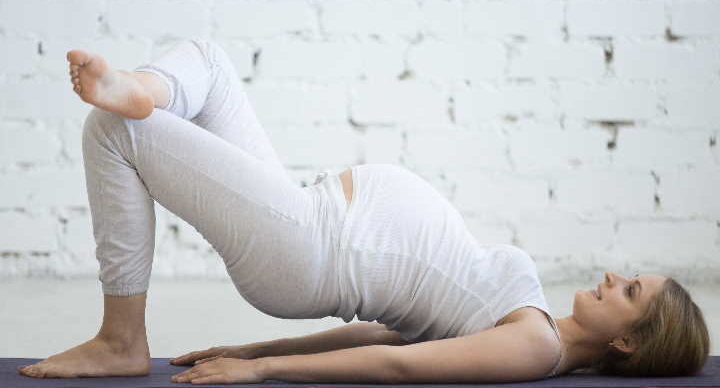
Prior to commencing on practicing yoga during your pregnancy, I will impart some knowledge about the advantages to your health, as well as some information about its history. You will also need to understand why I am endorsing prenatal yoga for your welfare, especially in your childbearing year.
Yoga actually dates back to a pre-historic era, in the Indus valley civilization times, dated between the fifth and second centuries before the birth of Christ. There is substantial evidence in the form of ancient seals, which have figurines in the lotus position to corroborate this.
The earliest written references are the “THE VEDAS” followed later by “THE UPANISHADS” which were basically the Sanskrit hymns of the Aryan people. This ancient form of yogic teaching was passed on from guru to disciple and has its roots embedded in ancient philosophy. This way of teaching has now flourished and spread throughout the world adapting and modifying itself to suit various cultures. It is popular in India as well as thriving in the West.
At the end of the Vedic period, which would be around 600 BC, The Bhagavad-Gita was written. This is in a poetic form of dialogues between Lord Krishna and the warrior prince Arjuna. His teachings and morals are beautifully imbibed in this epic poem. At around the same time that the Bhagavad-Gita was written, the Buddha lived and taught his philosophy, which also absorbed yogic practices and led to the evolution of Tantra. Thus, many great religions prospered around that particular time.

Yoga Sutras
One of the most well-known yoga texts is the classic Patanjali’s Yoga Sutras. Consisting of short passages which are easy to memorize, these aphorisms contain the essence of the essentials of yoga such as postures, breathing, meditation and spiritual guidance to both benefit your everyday living as well help towards enlightenment.
Moving on to the Middle Ages, was when texts such as the Hatha yoga Pradipka were written which further expanded on the purification of body, mind and the various techniques to do so. Due to the invasion and colonization of India, these various texts were translated, leading to the great love for the East, it’s traditions and its deeply rooted culture, as well as yoga which is flourishing throughout the world especially in the West.
This century has seen an unparalleled interest in western women’s intrigue with yoga, as recorded history tells us. In the past yoga was considered to be a male-dominated practice and tradition. However, yoga may be further rooted in our own culture and possibly practiced by women even before the evidence even supports its existence on the Indian subcontinent. Yoga actually dates much further back in history than anyone may have realized and is as old as civilization itself.

Now as we delve deeper into history, the revolutionary work of the renowned archaeologist Marija Gimbutas has disclosed the existence of ancient ‘matristic’ (female-centred) civilizations all over old Europe. What a discovery! She provides empirical evidence in the form of thousands of clay figurines of goddesses and other artefacts. These are dated back to the Palaeolithic (around 30,000 years ago) and Neolithic (9000 to 7000 years ago) Ages which she discovered throughout parts of Europe, ranging from Ukraine to the Mediterranean region. The point here that is extremely riveting and catches one’s attention is that many of the figurines of these matriarchal goddesses are actually yogic stances. They are clearly seated in yoga meditation postures, which clearly goes to show that the roots of meditational yoga in women’s circles can be dated back thousands of years and are to be found in our own prehistoric culture. It is a fascinating fact to realize that while yoga was considered pre-dominantly a male tradition, thanks to the intrinsic work of Marija Gimbutas, it is proven, without a doubt that women played a pivotal role in yoga meditation practices and postures in pre-historic culture. Her work related to these topics are ‘Gods and Goddesses Old Europe’ and ‘The Language of The Goddess’.
According to her, which she puts forth in The Language of the Goddess, The Goddess-centred religion was prevalent for an extremely long period of time, much longer than the Indo-European and the Christian era, leaving an indelible print on the western psyche. This of course is totally opposing to the 5000 years which followed in which patriarchal societies took over and dominated social life.
Though we currently live under the sway of male dominion, today more than ever the need is being felt to reawaken and connect with the feminine being. There is a compelling need all over the world, to awaken and transform our consciousness. We have been alienated from our authentic and ancient heritage, which we need to reconnect where both sexes were considered equal and we had a non-violent, earth-centred culture.
Now, there is no way to decode whether these goddesses were pregnant or not, while practicing yoga but it is safe to say that we are not the first women to think of practicing yoga whilst being pregnant. Perhaps in these ancient times the women knew how to connect with rejuvenating energies of nature by means of some basic ‘earth-centred meditation’. They might have known how to harness their inner core energies and maintained a ritual practice that empowered and provided nourishment to mind, body and soul by the divine power of the feminine being. They probably harmonized the rhythmic demands of nature along with the creative feminine powers.

Historical evidence of the ancient matriarchal civilizations points out to the fact that they were ‘gylanic’ in nature. What does gylanic mean? It means that both sexes were considered equal. A glorious era where equality prevailed. The feminine being or the ‘Godmother’ was revered and honoured as central to life. Women were worshipped and considered sacred, as birth givers and nurturers. All over the globe, in matriarchal cultures the woman is depicted as the female form of a sacred vessel or container accommodating and sustaining new life. The female form is the embodiment of fertility. Her fertility reflects and symbolizes the revitalizing power of living nature itself, not only in the human form but all life on the earth, in the entire universe as we know it. This is the glory of the feminine power!
A distinguishing fact of these ancient civilizations is that while they were renowned for their high refinement and distinction in art and lifestyle, peace and harmony also managed to prevail for thousands of years abiding with the laws of nature. This too is an exceptional achievement. Maintaining peace for thousands of years is not an easily conceivable feat. Yet our ancient ancestors managed it, giving due and the highest regard to women and abiding by the laws of nature.
PRENATAL YOGA in the WEST
As we know today, yoga has gone through various evolutions over the centuries, mainly in India to get to the evolved form it is at today. India is deeply rooted in its cultural beliefs. Our traditions and values date back to ancient eras. In India matriarchal values are considered sacrosanct and have remained intact for much longer than other parts of the world. While there maybe some factual evidence of women performing yoga, especially in the case of Tantric art, it is usually represented in India as being practiced by male yogis. Yoga in its contemporary form was brought forth to the West and popularized by male teachers from India, who have kept it alive through the centuries.
There are various kinds of yoga. Different postures and traditions but the one that has become highly popular in the West is ‘hatha yoga’. The main aim of hatha yoga is preparation of the body. Its focus is to potentially develop and prepare the body, to bring it into a balanced state for meditation. In order to achieve this state one needs to concentrate on breathing (pranayama) and postures known as asanas.

Yoga is beneficial in so many ways. It helps improve strength, balance and flexibility. There are several physical as well as mental advantages. Through meditation one connects with the inner core of their spiritual being. It is an emotional cleanse as well and brings about mental stability. Thus, the benefits of yoga are compounded many times over.
The approach to prenatal yoga has been inspired by the teachings of the late Vanda Scaravelli and her students. Living near Florence in Italy, this magnificent lady was originally tutored in the art of Yoga by B.K.S.Iyengar the world famous yoga teacher who toured the West and made hatha yoga acclaimed. It was through him that this form of yoga became famous throughout the world. Vanda Scaravelli has written the book ‘Awakening the Spine – A New Way of Yoga. She then went on to originate her own form of hatha Yoga. Her style has been given no name as of yet but it could be called as ‘Gravitational Yoga’ simply because it explains and deals with the way gravity affects our various postures. Gravity does affect us at all times, more so when we practice different yoga postures.
Since ancient times, the woman was always considered sacred and the giver of life. The female form was worshipped as the vessel of fertility. This is the beauty of our ancient teachings. If you are looking to hire a good offline or online prenatal yoga teacher, contact us today!
Do not miss a single article!
Submit your email id to get new articles directly into your email inbox!
- How We Conduct Online Zumba Sessions for Employees - December 30, 2022
- Prenatal Yoga During First Trimester - December 14, 2022
- Healthy Eating and Nutrition at the Workplace - October 13, 2022




Add Review